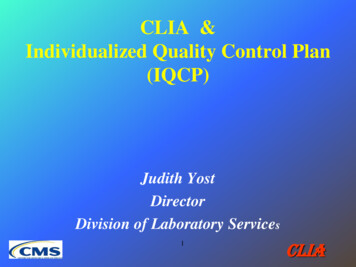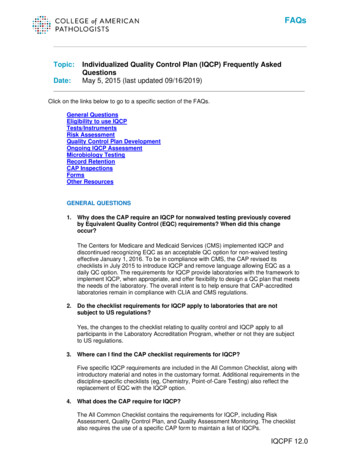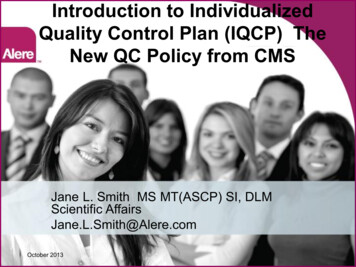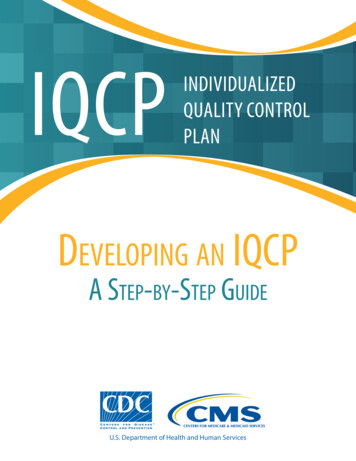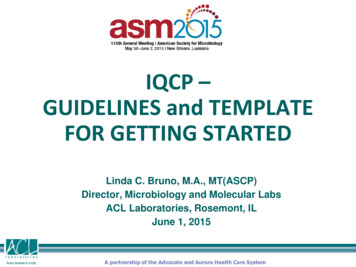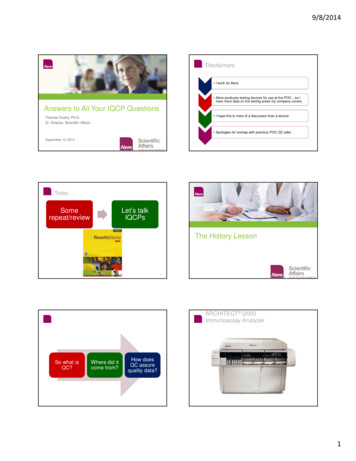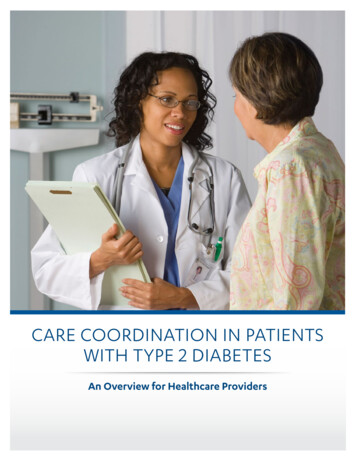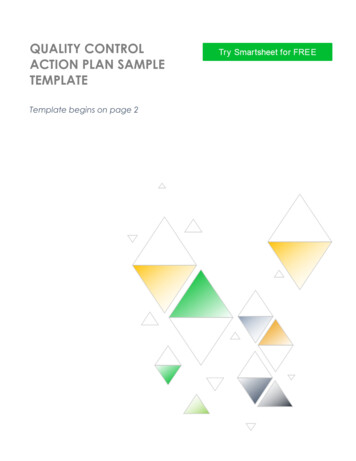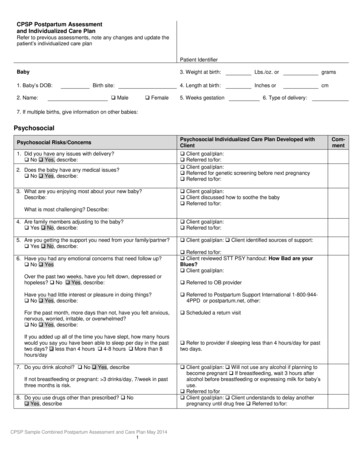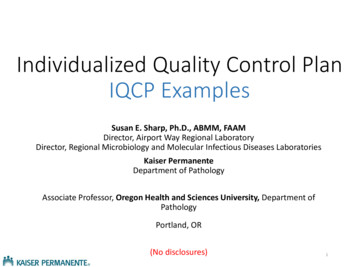
Transcription
Individualized Quality Control PlanIQCP ExamplesSusan E. Sharp, Ph.D., ABMM, FAAMDirector, Airport Way Regional LaboratoryDirector, Regional Microbiology and Molecular Infectious Diseases LaboratoriesKaiser PermanenteDepartment of PathologyAssociate Professor, Oregon Health and Sciences University, Department ofPathologyPortland, OR(No disclosures)1
3 Examples Cepheid Xpert MRSA Assay Vitek-2 Commercial AST Remel Exempt Media2
Cepheid Xpert MRSA Assay3
Cepheid Xpert MRSA AssayPackage insert (PI) contains system performance data anddescribes testing principle and procedure, QCrecommendations, and limitations. This PI is located in the microbiology laboratory’s PI files. No specific limitations were noted in the PI that would affectthe use of this test for our patient population; and no riskswere identified upon review of the PI. No manufacturer recommendations are given for external QC “External controls may be used in accordance with local, state,and federal accrediting organizations, as applicable.”Manufacturer alerts and bulletins are located with themicrobiology laboratory’s PI files. No risks were identified upon review of any alert/bulletin.4
Literature J Clin Microbiol. Oct 2008; 46(10): 3285–3290. Evaluation of the XpertMethicillin-Resistant Staphylococcus aureus (MRSA) Assay Using theGeneXpert Real-Time PCR Platform for Rapid Detection of MRSA fromScreening Specimens. Angela S. Rossney, Celine M. Herra, Gráinne I.Brennan, Pamela M. Morgan, and Brian O'Connell. J. Clin. Microbiol. March 2009 vol. 47 no. 3 758-764. Multicenter Evaluationof the Cepheid Xpert Methicillin-Resistant Staphylococcus aureus (MRSA)Test as a Rapid Screening Method for Detection of MRSA in Nares. D. M.Wolk, et al.The above pertinent published studies have been reviewed and no riskfactors were identified that would affect the performance of this assay inour laboratory.Copies of these articles, along with our initial verification testingdocumentation, are located in the microbiology supervisor’s Xpertverification files.5
CAP IQCP Accreditation RequirementsThis IQCP is in compliance with all CAPChecklist RequirementsSee Common Checklist items: COM.50200 (IQCP test list) COM.50300 (RA) COM.50400 (QCP approval) COM.50500 (QCP defined) COM.50600 (QA monitoring)6
Historical QC data - SummaryHistorically, QC has been performed as outlined in the most current version ofSOP.1234. Briefly, 1 positive and 3 negative external controls are utilized for allQC testing (unless indicated otherwise below):Review of data for the past 12 months (4/1/14 - 3/31/15) using New Lot and/or shipment QC (performed for 6 lot/shipment checks)*Major maintenance (performed twice during the time period)Software upgrades (performed once during time period)Bi-weekly QC using 1 positive and 1 negative control - rotating the negativecontrols (24 QC cycles using 1 positive and 1 negative control)* 2% (1.8%) failures of external QC* (which were within limits upon repeat testing).No external QC failures were noted after system maintenance or softwareupgrades.No internal QC failures were noted when testing patient samples (327 days).7
RISK ASSESSMENT: Identification of Potential Risks - Cepheid Xpert MRSA ransport-Storage-Volume2OperatorOperator function-Training-Competency assessment-Proficiency testing-Staffing levels4EnvironmentFactors:-Temperature-PCR freeIdentify ons date-QC3ReagentsIncorrect TestResults ReleasedInstrument-Electric-Maintenance-Function checks5Test SystemReported Results-Review of released results-Clinician feedback-Release from LIS to HIS6Test ResultsPre-analyticalAnalyticalPost-analytical8
Risk Assessment Tables1 Sample - PreanalyticalXpert MRSA sures to control riskRelevant SOP -IdentificationOccasionalCriticalSpecimen identification criteria aredefined. Training (TR) completed.Competency assessment sionalNegligible– MinorCollection criteria are defined.Training completed.CA lNegligible– MinorTransport criteria are defined.Training completed.CA egligible– MinorStorage criteria are defined.Training completed.CA gligibleRejection criteria are defined.Training completed.CA performed.SOP.xxxxTR.xxxxCA.xxxxDocumentation9
2 Operator - AnalyticalXpert MRSA easures to control riskRelevant SOP DocumentationTrainingOccasionalMinor –CriticalAll testing personnel have hadappropriate training beforeperforming this lMinor –CriticalAll personnel have appropriatecompetency assessment (CA)performed on this orAll staff participate in PT andreview all final critiques. All PTfailures with this assay areaddressed with corrective action.SOP.xxxxOccasionalMinor –CriticalAdequate staffing to support thistest and turn-around-times isavailable on all shifts.SOP.xxxxStaffing10
3 Reagents - AnalyticalXpert MRSA easures to control riskRelevant SOP DocumentationReceiving/StorageOccasionalMinor –CriticalReagents for the Xpert MRSA assay arestored according to esUnlikelyMinorAll reagents used in the Xpert MRSA areused within expiration dates.SOP.xxxxQCUnlikelyNegligibleAll QC results for the Xpert MRSA assayare within parameters prior to releasingpatient results.All specimen-specific QC parameters arecontrolled within the cartridge; if there isa failure, the assay will not deliver apatient result. The result will be an"error" or an "invalid”.SOP.xxxxmanufacturer’spackage insert11
4 Environment - AnalyticalXpert MRSA rmMeasures to control riskRelevant SOP ate environmentalconditions are maintained in thelaboratory.SOP.xxxxPCR freeUnlikelyNegligibleBenches are bleached prior toperforming testing; gloves areused for testing; procedures forreducing cross-contamination areused. Also, the test cartridges forthe Xpert MRSA assay are selfcontained - amplicons cannotescape unless the cartridgeintegrity is damaged. Properdiscarding and decontaminationprotocols are followed fordisposal of all cartridges.SOP.xxxxmanufacturer’spackage insert12
5 Test System - AnalyticalXpert MRSA assay5Test SystemFrequencyofOccurrenceSeverityofHarmMeasures to control riskRelevant SOP DocumentationElectricUnlikelyNegligibleAppropriate utilities areemployed in the laboratory toserve the Xpert ligibleCriteria are defined toaddress Xpert MRSAinstrument kelyNegligibleCriteria are defined toaddress failures associatedwith the Xpert MRSAsystem/instrument.SOP.xxxxQC-FORM.xxxx13
6 Test Result - PostanalyticalXpert MRSA assay6Test ResultFrequencyofOccurrenceSeverityofHarmMeasures to control riskRelevant SOP DocumentationReview ofreleased resultsOccasionalMinor –CriticalCriteria are defined to addressreview of released results andinvestigate any errors detectedrelated to the Xpert MRSA assay.SOP.xxxxClinicianfeedbackUnlikelyMinor –CriticalCriteria are defined to addressclinician feedback and investigateconcerns with the Xpert MRSAassay.SOP.xxxxRelease fromLIS to HISUnlikelyNegligible– MinorCriteria are defined for periodicreview of results transfer relatedthe Xpert MRSA assay.SOP.xxxx14
Quality Control Plan for Xpert MRSA assayQCP for the Xpert MRSA screening assay will consist of following instructions inSOP.xxxx and recording results on QC-FORM.A (external controls) and QCFORM.B (internal controls).QC will include: External QC (1 positive and 1 negative) performed per lot/shipment (rotatingthe negative targets). External QC (1 positive and 1 negative) performed the second week of eachmonth (rotating the negative targets). The Internal Controls are to be acceptable and documented each day patientsamples are tested.Acceptable QC is defined in SOP.xxxx.15
Post-implementation Quality Assessmentmonitoring process will include all of the following: Specimen collection/acceptability guidelines reviewed annually See SOP.xxxx Staff Training updated annually as necessary See SOP.xxxx Competency assessment performed semi-annually and annually as required See SOP.xxxx Proficiency Testing results review and mediated ASAP as required See SOP.xxxx QC/Instrument Function checks reviewed and mediated ASAP as required See SOP.xxxx, SOP.xxxx. QC-FORM.xxxx, QC-FORM.xxxx Unexpected Errors investigated ASAP and remediated See SOP.xxxx Laboratory error investigation/remediation performed ASAP See SOP.xxxx Complaint investigation/remediation performed ASAP See SOP.xxxxPre-analyticalAnalyticalPost-analyticalFor errors/ failures/concerns areassessment of riskwill be performed. The reason forfailure will beidentified andrelated to anew/updatedrisk. Additionalcontrolmeasures will beimplemented ifnecessary asdetermined bythe new riskassessment.16
IQCP for Xpert MRSA assayThis IQCP/QCP has been reviewed and is approved by the CLIA laboratory director:(director signature)(date)17
Vitek-2 Commercial AST System18
IQCP for Vitek-2 Antimicrobial Susceptibility Testing (AST) SystemOur Regional Medical CenterTest System Primary SOPs include:SOP.111 “Processing Microbiological Specimens”SOP.222 “Vitek-2 Performance/Maintenance”SOP.333 “Guidelines for Selecting Isolates for AST”Historical Quality Review:CLIA ’88/CMS requires testing of QC strains daily (or each day patient’s tests areperformed) for AST.Previously CLIA recognized use of CLSI standards M100 and M07 which indicate thatweekly testing of QC strains is acceptable following documentation of satisfactory dailyQC testing. Our laboratory has been following the CLSI standards for over 20 years without any significantQC problems.It is rare to encounter an out-of-range result with a QC strain that indicates a test systemproblem.Nearly all testing errors or delays in reporting occur with individual patient isolates and theseerrors are unrelated to testing QC strains and are also unrelated to a problem with the Vitek-2.Processes to mitigate patient reporting errors and delayed reports as well as QC areaddressed in this IQCP.
Information Used to Conduct Risk AssessmentRegulatory and Accreditation Requirements:See CAP IQCP checklist questions in the CAP COMMON checklist.NOTE: Our IQCP is in compliance with CMS and CAP requirements. Copies of theserequirements are located in our Compliance Department.Method verification:Instrument received and test system verification completed in year 2012. Subsequentverifications performed when new drugs were added (1/12/14 and 4/14/15). Thisdocumentation is filed in Vitek-2 verification files. All verifications were deemedacceptable by the Laboratory Director.Training of personnel:Completion of training documented in Compliance Department office.Competency Assessment:New employees 6 months after initial training and annually thereafter. Documentationfiled in Compliance Department office.Proficiency Testing:All personnel will test and review results. Proficiency testing records filed insupervisor’s office.
VITEK-2 InformationManufacturer:Package insert contains system performance data and describes testing principleand procedure, QC recommendations, and limitations. Package insert is located inthe supervisor’s office.Manufacturer alerts and bulletins are located the supervisor’s office.NOTE: No risks were identified when looking at the PI for this system. Both the Limitationsand Performance data sections were closely reviewed to identify possible risks associatedwith the system and none were found.Scientific publications used during collection of information for RA:Smith et al. 2012. J Laboratory Testing. 52:109Jones and Cartwright. 2015. Microbiology Today. 18:1821CLSI document M07-A10. 2015NOTE: Upon review of these articles no risk factors were identified.
VITEK-2 DataSummary of in-house QC data from routine testing of QC strains.Review period from 3-14-14 to 3-13-15.QC testing was performed according to SOP.2222.Review of QC records for 1 year of 3500 results demonstrated: 0.8% occurrence of random QC errors (corrected upon repeattesting) 0.02% occurrence (one incident) of potential system QC error thatrequired corrective action. This involved an out-of-range QC results with imipenem that was presumed tobe due to drug degradation following improper storage of 1 box of panels. Additional panels from this box were QC’d and found to be out-of-range;panels were discarded, none were used for patient testing.
Vitek-2 Instrument Information:Summary of in-house data from routine instrumentmaintenance and performance checks (doneaccording to SOP.2222): Review of instrument QC records for the past 12 months (3-14-14to 3-13-15) included approximately 55 routine checks ofinstrument A and 55 routine checks of instrument B. There was 1 scheduled maintenance performed by the company’sservice engineer (8-1-14).NOTE: None of these reviews showed any performance problemswith the Vitek-2 that would impact patient results.
Laboratory Data:Summary of corrected reports and physician complaints (documentation located insupervisor’s office):Review of reporting errors (corrected reports), physician complaints, and delayedreports ( 5 days after specimen collection) for these 12 months showed 38 corrected reports showed errors were due to one or more of the following:1.2.3.4.inappropriate antimicrobial agent reported for the species/body site (n 17)incorrect result released due to mixed culture (n 9)incorrect result released due to use of inappropriate MIC interpretation (n 8)failure to perform a susceptibility test when warranted (n 4)2 formal physician complaints revealed:1. question of a result for S.aureus isolate - repeat testing initial results were incorrect2. delay in reporting results for a CRE due to the need to confirm results5 AST reports delayed 5 days were due to:1. verification of an MDR phenotype needing confirmatory testing (n 4)2. failure of the operator to “finalize” the report (n 1)Note: during this review of corrected reports and physician complaints, none of theerrors could have been avoided by any changes in protocol for testing of QC strainsincluding frequency of testing QC strains.
Frequency ofoccurrenceSeverity ofharm topatientRisk LevelPatient identificationprobableminorNot gibleNot AcceptableIntegrityfrequentnegligibleNot AcceptableTransportfrequentnegligibleNot AcceptableStorageSpecimen (Organism):Clinically relevantColony ageMedia typePure isolateInoculum usminorNot AcceptableNot AcceptableAcceptableNot ousnegligibleminorNot casionalminorminornegligibleAcceptableNot ceptableNot leseriousseriousseriousseriousNot AcceptableAcceptableNot AcceptableNot AcceptableRisk Factor(Possible Sources of Error)PreanalyticalSpecimen (Primary):AnalyticalTesting Personnel:Training and CompetencyProficiency ons datesPreparation/useQC strain storage/prepEnvironment:Conditions - /noise/ vibrationTest bial reporting rulesTransmission of results to LISPostanalyticalTest Results:Results reported within 5 daysTransmission of results from LIS to HISReview reported resultsClinician feedback
Risk Factor(Possible Sources of Error)Frequency ofoccurrenceSeverity ofharm topatientRisk LevelPreanalyticalSpecimen (Primary):Patient Transport (Organism):SpecimenStorage relevantClinicallyColony ageMedia typePure isolateInoculum bleminorNot AcceptableNot AcceptableNot AcceptableNot requentoccasionalminorminorseriousminorNot AcceptableAcceptableNot AcceptableAcceptable
Risk Factor(Possible Sources of Error)FrequencyofoccurrenceAnalyticalSeverity ofharm topatientRisk LevelTesting Personnel:Training and CompetencyProficiency gligibleminorNot casionalminorminornegligibleAcceptableNot ceptableNot irations datesPreparation/useQC strain storage/prepEnvironment:Conditions /noise/ vibrationTest bial reporting rulesTransmission of results to LIS
Risk Factor(Possible Sources of Error)Frequency ofoccurrenceSeverity of harmtopatientRisk LevelPostanalyticalTest Results:Results reported within 5 daysprobableseriousNot AcceptableTransmission of results from LIS to HIS unlikelyReview reported resultsfrequentseriousseriousAcceptableNot AcceptableClinician feedbackseriousNot Acceptableprobable
Risk Acceptability AssignmentPossible Sources of ErrorRisk FactorHow can identified sources of error be reduced?Possible ErrorPreanalytical1A: Specimen - BiologicalPatient/specimen identificationCollection/container/ volumeTransportStorage1B: Specimen - Organism Improper specimen procurement/ handling/processingClinically relevantClinically irrelevant organisms testedAdditional species may be significant in select patient types (e.g., immunosuppressed)Physicians may request testing of isolates that are not clinically relevant; requests may be inappropriate and results misleadingOld or less viableColonies on source plate 1 day oldMedia typeMedia for inoculum source other than that recommended is usedPanel fails to support growth of test organismPure isolateMixed inoculum or contaminated panelInoculum suspensionOverinoculation or underinoculationUse of nonviable coloniesSpecies appropriate 2: Testing PersonnelIncompletely trainedUnaware of updated recommendations for AST/reportingTesting of species not indicated for test systemTrainingCompetencyExperienceProficiency TestingStaffingInadequate to perform testing without errors3: ReagentsReceiving/storageIncorrect orderingDepleted reagent supplyReagent integrity compromisedExpiration datesPreparation/use Use incorrect panel/card for select organismQC strain storage/prep QC out of control due to improper QC strain maintenance4: Environment Results not reported (ancillary equipment failure, e.g., incubator malfunction)Temperature/airflow/humidity/ ventilationUtilitiesSpaceNoise/vibration5: Test SystemMechanical/electronic/jamResults not reported (e.g., instrument malfunction and/or aborted test)Software/antimicrobial reporting rules Transmission of results to LISIncorrect transmission of resultsDelay in transmission of results6: Test ResultsResults reported within 5 daysTransmission of results to Electronic Health RecordReview reported resultsClinician feedback Inappropriate drugs reportedMICs interpreted incorrectlyErroneous results reportedReport comments missing or inappropriate for the cultureResults delayed beyond that expected for organism typeIncorrect transmission of resultsDelay in transmission of results Inappropriate drugs reported Erroneous results reported MICs interpreted incorrectly Report comments missing or inappropriate for the culture Complaints/suggestions regarding delayed results and potential erroneous resultsAdhere to procedures in SOP #2.1.1 that addresses patient identification and specimen collection, labeling, transport, storage and remedial actions to control improperly handled specimens ordelayed specimens. Annually review representative specimen processing errors (N 10 to 15) with all staff involved with patient specimens.During initial training and competency assessment, emphasize: Proper specimen handling/processing is the most critical part of any test Failure to streak correctly (no isolated colonies) and delayed incubation may result in delayed AST reportsSOP 5.1.3 describes selecting organisms to test for AST based on organism ID, specimen source and quantityPhysicians can request additional testing in select patients; comment added to final report indicating name of physician initiating special request. Supervisor/director discusses with requesting physician thoserequests that may be inappropriate.During initial training and competency assessment, emphasize: Organism growth requirements (especially S. pneumoniae)During initial training and competency assessment, emphasize: Appropriate media for inoculum Species that can be reliably tested by test system based on manufacturer’s recommendationsSolicit regular feedback on streaking of primary plates (for isolated colonies)Inoculate purity plateDaily review of AST profiles for aberrant results possibly due to mix/contaminationDuring initial training and competency assessment, emphasize: Proper organism selection for inoculum preparation Risks of selecting “young” colonies or poorly isolated colonies Potential sources of contamination during testing process Impact of delayed results (if retesting needed) Turbidity meter for inoculum standardization Monthly colony counts of representative QC strainsDuring initial training and competency assessment, emphasize: Proper inoculum suspension preparation Impact of overinoculation (false R) or underinoculation (false S)During initial training and competency assessment, emphasize: Species that can be reliably tested by test system based on manufacturer’s recommendationsAnalyticalDuring initial training and competency assessment, emphasize:Key aspects of AST to include those described in this IQCPSupervisor annually review any changes in AST recommendations described by accrediting agencies or standards organizationsSee above (Testing Personnel)See above (Testing Personnel)Supervisor review AST reports generated by new employees prior to release for the first two months of their employmentAll staff read (and sign off) on PT sample critiques Supervisor to annually review appropriate staffing needs for AST and schedule staff accordinglyDuring initial training and competency assessment, emphasize standard rules to always: Take responsibility for reagents/supplies (all staff) Maintain reagents at proper storage conditions Check expiration dates Perform required QC Designated staff member(s) assigned to inventory (order/receipt) AST reagents to ensure inventory properly maintained and testing materials are handled appropriately on receiptSee above (Reagents) Use color codes on boxes of panelsDuring initial training and competency assessment, emphasize: Proper maintenance of QC strains (limited number of subcultures) Potential sources of QC failures QC troubleshooting QC frequency Role of QC strains versus other QA measures to ensure reliable reporting of patient results Instrument installed at a location following manufacturer’s suggestions.During initial training and competency assessment, emphasize standard rules for: Take responsibility for any possible instrument/ environmental problem (out of the ordinary observation)(all staff)Equipment maintenanceTemperature recording (done automatically with continuous monitoring device)Electrical supplySee above (Environment)See above (Environment)N/A (sufficient space available)See above (Environment)During initial training and competency assessment, emphasize standard rules for: Take responsibility for any possible instrument/test system problem (out of the ordinary observation) Perform preventive maintenance according to recommended scheduleDuring initial training and competency assessment, emphasize: How to avoid and resolve jams Software rules address (and flag) most (but not all) potential errors to be checked by tech; sometimes note for tech follow up action printed on internal report Software flags unusual results requiring supervisor review Daily supervisor (or supervisor designee) review of reported resultsDuring initial training and competency assessment, emphasize:Intrinsic resistance patterns of commonly encountered speciesResults requiring follow up action (e.g., confirmation by repeat testing)Results requiring consultation with supervisor/director PostanalyticalDaily supervisor (or supervisor designee) review of reported resultsAnnual check of test system- LIS computer interfaceQA monitor for time to reporting AST results Supervisor maintains summary of incorrect results released and meets with laboratory director monthly to review this summary QA monitor for time to reporting AST resultsDuring initial training and competency assessment, emphasize:Need for timely results to guide therapy and identify potential multidrug resistant organisms that might require patient isolationReporting preliminary results (timely reporting)See above (Test Results)See above (Test Results and Test System)Note: results are checked at multiple steps by tech and then by supervisorSee above (Test Results) Incorporate suggestions into QA plan, as appropriate.
Risk Acceptability AssignmentPossible Sources of ErrorHow can identified sources of error bereduced?Risk FactorsPossible ErrorsPreanalytical1A: Specimen(patient)Patient identificationCollection/container/volumeTransport Improper specimen procurement/handling/processing Adhere to procedures in SOP.1111 thataddresses patient identification and specimencollection, labeling, transport, storage andremedial actions to control improperlyhandled specimens or delayed specimens.Annually review of selected specimenprocessing errors (N 10 to 15) with all staffinvolved with patient specimens.StorageDuring initial training and competency assessmentemphasize: Proper specimen handling and processing isa very critical part of any patient testing Failure to streak plates correctly ( noisolated colonies) can lead to a delay in reportingAST for patients
Risk Acceptability AssignmentPossible Sources of ErrorRisk FactorsPossible ErrorsHow can identified sources of error bereduced?Preanalytical1B: Specimen(organism)Clinically relevantColony ageMedia typePure isolateInoculum suspension-Clinically irrelevantorganisms tested-Physicians may requesttesting of non-significantisolates; requests may beinappropriate.Colonies 1 day oldIncorrect media used forinoculumMixed inoculum-Overinoculation orunderinoculation-SOP.333 describes selecting organisms to test based onorganism ID, specimen source and quantity-Supervisor/director discusses with requesting physician thoserequests that may be inappropriate.During initial training and competency assessment emphasize:-Organism growth requirements (especially S. pneumoniae)During initial training and competency assessment emphasize:-Appropriate media for inoculum-Inoculate purity plate-Daily review of results for errors due to mixed inoculumDuring initial training and competency assessment emphasize:-Proper organism selection for inoculum preparation-Risks of selecting “young” colonies or poorly isolated colonies-Impact of delayed results (if retesting needed)Turbidity meter for inoculum standardizationDuring initial training and competency assessment emphasize:-Impact of overinoculation (false R) or underinoculation (false S)
Risk Acceptability AssignmentPossible Sources of ErrorHow can identified sources of errorRisk FactorsPossible Errorsbe reduced?Analytical2: TestingPersonnelTraining andCompetencyProficiencyTestingStaffing Incompletelytrained Unaware ofupdatedrecommendationsfor AST/reportingErrors in PTperformanceInadequate toperform testingwithout errorsDuring initial training and competencyassessment emphasize: Key aspects of AST Supervisor annually review anychanges in AST recommendationsdescribed by CLSI/FDA All staff perform and review all PTsample critiques Supervisor to annually reviewappropriate staffing needs for ASTand schedule staff accordingly
Risk Acceptability AssignmentPossible Sources of ErrorRisk FactorsPossible ErrorsHow can identified sources of error bereduced?Analytical3: ReagentsReceiving/storageExpiration dates Preparation/use QC strainstorage/prep Incorrect orderingDepleted reagentsupplyReagent integritycompromisedReagents used pastexpiration dateDuring initial training and competencyassessment emphasize: Take responsibility for reagents/supplies (allstaff) Maintain reagents at proper storageconditions Check expiration dates prior to use Perform required QC Use color codes on boxes of panelsIncorrect AST cardused for organismQC out of control due During initial training and competencyto improper QC strain assessment emphasize:maintenance Proper maintenance of QC strains Potential sources of QC failures QC troubleshooting QC frequency
Risk Acceptability AssignmentPossible Sources of ErrorHow can identified sources of errorRisk FactorsPossible Errorsbe reduced?Analytical4: y-ventilation-utilities-noise-vibration Results notDuring initial training and competencyreported/delayed assessment emphasize: Take responsibility for any possibleinstrument/environmentalproblem/out of the ordinaryobservation (all
Training of personnel: Completion of training documented in Compliance Department office. Competency Assessment: New employees 6 months after initial training and annually thereafter. Documentation filed in Compliance Department office. Proficiency Testing: All personnel will test and review results. Proficiency testing records filed in
